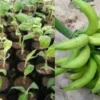- このトピックは空です。
- 投稿者投稿
- 3月 26, 2025 10:41 am #607272

Crop plants, the very foundation of global agriculture and human sustenance, exhibit a remarkable array of physical forms and growth patterns.
Understanding this diversity through morphological classification of crop plants is essential for effective agricultural management, breeding programs, and the broader study of plant science.
By categorizing these vital species based on their observable structural characteristics, we gain valuable insights into their growth habits, resource requirements, and potential uses. This article will delve into several key morphological classifications that help us organize and comprehend the vast world of cultivated plants.
1. Classification Based On Life Span
The duration of a crop plant’s life cycle is a fundamental aspect of its biology and significantly influences cultivation practices. Annual crops, such as maize, rice, and wheat, complete their entire life cycle from germination to seed production within a single growing season. This necessitates annual planting and harvesting.
Biennial crops, like carrots and onions, require two growing seasons; they typically develop vegetatively in the first year and flower and produce seeds in the second.
Perennial crops, including fruit trees like mangoes and citrus, as well as forage grasses, live for more than two years, often producing harvests year after year. This classification based on lifespan dictates the frequency of planting and the long-term management strategies required for each type of crop.
2. Classification Based On Stem Characteristics And Growth Habit
The nature of a crop plant’s stem and its overall growth habit provides another crucial means of classification. Herbaceous crops, like most vegetables and cereals, possess soft, non-woody stems. Shrub crops, such as tea and coffee, are characterized by multiple woody stems arising from the base, resulting in a bushy form.
Tree crops, including fruit trees like apples and oranges, have a single, prominent woody trunk. Additionally, there are climbing or vine crops, such as grapes and passion fruit, which possess flexible stems that require support to grow vertically. Understanding these stem characteristics is vital for determining appropriate planting density, trellising needs, and harvesting methods.
3. Classification Based On Specialized Morphological Structures
Certain crop plants are distinguished by unique modified structures that serve specific functions, often related to storage or propagation. Bulb crops, such as onions and garlic, possess underground bulbs, which are modified stems consisting of fleshy leaves that store nutrients.
Tuber crops, like potatoes and yams, develop tubers, which are swollen underground stems specialized for carbohydrate storage. Root crops, including carrots and radishes, are characterized by their enlarged taproots or adventitious roots that serve as storage organs. Recognizing these specialized structures is key to understanding the edible parts of these crops and their specific harvesting requirements.
4. Classification Based On Leaf Morphology
While not always the primary classification, the characteristics of a crop plant’s leaves can provide valuable distinctions. Leaf shape, size, arrangement on the stem, and surface texture can vary significantly between different crop types.
For instance, broadleaf crops, encompassing many vegetables and legumes, have wide, flattened leaves, while narrow-leaf crops, such as grasses and cereals, possess long, slender leaves. Leaf morphology can influence the plant’s photosynthetic efficiency and its adaptation to different light conditions.
5. Classification Based On The Primary Use Of The Plant Or Plant Part
Although this classification leans towards functional rather than strictly morphological aspects, it is often intertwined with physical characteristics. Crop plants are frequently categorized based on the primary part that is utilized.
For example, cereals are grown for their grains (seeds), legumes for their pods and seeds, fruits for their fleshy or dry mature ovaries, vegetables for their various edible parts (roots, stems, leaves, flowers), and fiber crops for their elongated cells in stems, leaves, or fruits.
This classification highlights the economic importance of different plant parts and often correlates with specific morphological adaptations.
The morphological classification of crop plants offers a comprehensive framework for understanding the diversity within our cultivated plant resources.
By categorizing crops based on their lifespan, stem structure, specialized structures, leaf characteristics, and primary use, we gain valuable insights that inform agricultural practices, breeding strategies, and our overall appreciation for the plant kingdom’s contribution to human society.
This systematic approach allows for more effective communication, research, and management of these essential plants.
Read Also: Beyond the Kitchen: Unveiling the Industrial and Sustainable Uses of Oil Crops
- 投稿者投稿
- このトピックに返信するにはログインが必要です。






